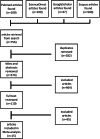Cognitive rehabilitation for improving cognitive functions and reducing the severity of depressive symptoms in adult patients with Major Depressive Disorder: a systematic review and meta-analysis of randomized controlled clinical trials
- PMID: 36707847
- PMCID: PMC9883940
- DOI: 10.1186/s12888-023-04554-w
Cognitive rehabilitation for improving cognitive functions and reducing the severity of depressive symptoms in adult patients with Major Depressive Disorder: a systematic review and meta-analysis of randomized controlled clinical trials
Abstract
Introduction: Nearly 40% of patients with Major Depressive Disorder (MDD) have been found to experience cognitive impairment in at least one domain. Cognitive impairment associated with MDD is disproportionately represented in patients that have not fully returned to psychosocial functioning. As awareness regarding cognitive dysfunction in MDD patients grows, so does the interest in developing newer treatments that specifically address these deficits.
Method: In the present study, we conduct a systematic review of controlled randomized clinical trials that used cognitive training and remediation interventions for improving cognitive functions and reducing symptom severity in adult patients with MDD. We selected studies published before March 2022 using search databases including PubMed, ScienceDirect, Scopus, and Google scholar. For conducting the meta-analysis, standard differences in means with the random effect model and with a 95% confidence interval of change in outcome measures from baseline to post-intervention between the cognitive rehabilitation and the control groups were calculated.
Results: The database search resulted in identifying 756 studies of interest, which ultimately 15 studies with 410 participants in the cognitive rehabilitation group and 339 participants in the control group were included. The meta-analysis of the data extracted from these studies, shows a moderate and significant effect on the executive function (d = 0.59 (95% CI, 0.25 to 0.93) p-value = 0.001, I2 = 15.2%), verbal learning (d = 0.45 (95% CI, 0.12 to 0.78) p-value = 0.007, I2 = 0.00%), and working memory (d = 0.41 (95% CI, 0.18 to 0.64) p-value < 0.001, I2 = 33%) of MDD patients. Although, there were no significant difference between intervention and control group in attention (d = 0.32 (95% CI, -0.01 to 0.66) p-value = 0.058, I2 = 0.00%) or depressive symptoms.
Conclusion: This systematic review and meta-analysis indicate that cognitive rehabilitation is an effective intervention for the executive function, verbal learning, and working memory of MDD patients. Due to the importance of these neuropsychological deficits in day-to-day life and the core symptoms of MDD, cognitive rehabilitation should be considered an important part of treating MDD. Further research in this area and concentrated on these particular deficits is warranted.
Keywords: Cognitive Function; Executive function; Major Depressive Disorder; Meta-Analysis; Systematic Review; Verbal learning; Working memory.
© 2023. The Author(s).
Conflict of interest statement
The authors have no conflicts of interest to report.
Figures












Similar articles
-
Long-term cognitive effects of electroconvulsive therapy in major depressive disorder: A systematic review and meta-analysis.Psychiatry Res. 2024 Jan;331:115611. doi: 10.1016/j.psychres.2023.115611. Epub 2023 Dec 1. Psychiatry Res. 2024. PMID: 38101070
-
Neuropsychological Assessments of Cognitive Impairment in Major Depressive Disorder: A Systematic Review and Meta-Analysis with Meta-Regression.Psychother Psychosom. 2024;93(1):8-23. doi: 10.1159/000535665. Epub 2024 Jan 25. Psychother Psychosom. 2024. PMID: 38272009 Free PMC article.
-
Cognitive function following a major depressive episode: a systematic review and meta-analysis.Lancet Psychiatry. 2019 Oct;6(10):851-861. doi: 10.1016/S2215-0366(19)30291-3. Epub 2019 Aug 15. Lancet Psychiatry. 2019. PMID: 31422920
-
Preliminary evidence concerning the pattern and magnitude of cognitive dysfunction in major depressive disorder using cogstate measures.J Affect Disord. 2017 Aug 15;218:82-85. doi: 10.1016/j.jad.2017.04.064. Epub 2017 Apr 27. J Affect Disord. 2017. PMID: 28460315 Free PMC article.
-
Cognitive functioning and lifetime major depressive disorder in UK Biobank.Eur Psychiatry. 2020 Feb 21;63(1):e28. doi: 10.1192/j.eurpsy.2020.24. Eur Psychiatry. 2020. PMID: 32189608 Free PMC article.
Cited by
-
Clinical practice guidelines - An overview of cognitive remediation for various neuropsychiatric disorders.Indian J Psychiatry. 2025 Jan;67(1):8-20. doi: 10.4103/indianjpsychiatry.indianjpsychiatry_1191_24. Epub 2025 Jan 13. Indian J Psychiatry. 2025. PMID: 40046488 Free PMC article. No abstract available.
-
A naturalistic analysis of rTMS treatment outcomes for major depressive disorder in West Australian youth.Front Psychiatry. 2025 Mar 4;16:1513339. doi: 10.3389/fpsyt.2025.1513339. eCollection 2025. Front Psychiatry. 2025. PMID: 40104331 Free PMC article.
-
The NNDC Road Map for Depression Care and Focused Areas of Research.Focus (Am Psychiatr Publ). 2025 Apr;23(2):217-218. doi: 10.1176/appi.focus.25023008. Epub 2025 Apr 15. Focus (Am Psychiatr Publ). 2025. PMID: 40235609 No abstract available.
-
Effectiveness of Cognitive Rehabilitation in Improving Symptoms and Restoring Cognitive Functions in Patients with Depression: An Updated Meta-Analysis of Randomized Controlled Trials.Alpha Psychiatry. 2024 Nov 1;25(6):727-736. doi: 10.5152/alphapsychiatry.2024.241731. eCollection 2024 Nov. Alpha Psychiatry. 2024. PMID: 39830048 Free PMC article. Review.
-
Cognitive Deficits in Late-Life Depression: From Symptoms and Assessment to Therapeutics.Focus (Am Psychiatr Publ). 2025 Apr;23(2):183-194. doi: 10.1176/appi.focus.20240046. Epub 2025 Apr 15. Focus (Am Psychiatr Publ). 2025. PMID: 40235602 Review.
References
-
- Araminia B, Shalbafan M, Mortezaei A, Shirazi E, Ghaffari S, Sahebolzamani E, et al. L-Carnosine combination therapy for major depressive disorder: A randomized, double-blind, placebo-controlled trial. J Affect Disord. 2020;267:131–136. - PubMed
-
- American Psychiatric Association. Diagnostic and statistical manual of mental disorders. 5th ed. Arlington: American Psychiatric Association; 2013.
-
- Ghazizadeh-Hashemi M, Ghajar A, Shalbafan M-R, Ghazizadeh-Hashemi F, Afarideh M, Malekpour F, et al. Palmitoylethanolamide as adjunctive therapy in major depressive disorder: A double-blind, randomized and placebo-controlled trial. J Affect Disord. 2018;232:127–133. - PubMed
-
- Chiriţă AL, Gheorman V, Bondari D, Rogoveanu I. Current understanding of the neurobiology of major depressive disorder. Rom J Morphol Embryol. 2015;56(2 Suppl):651–658. - PubMed
Publication types
MeSH terms
Grants and funding
LinkOut - more resources
Full Text Sources
Research Materials

